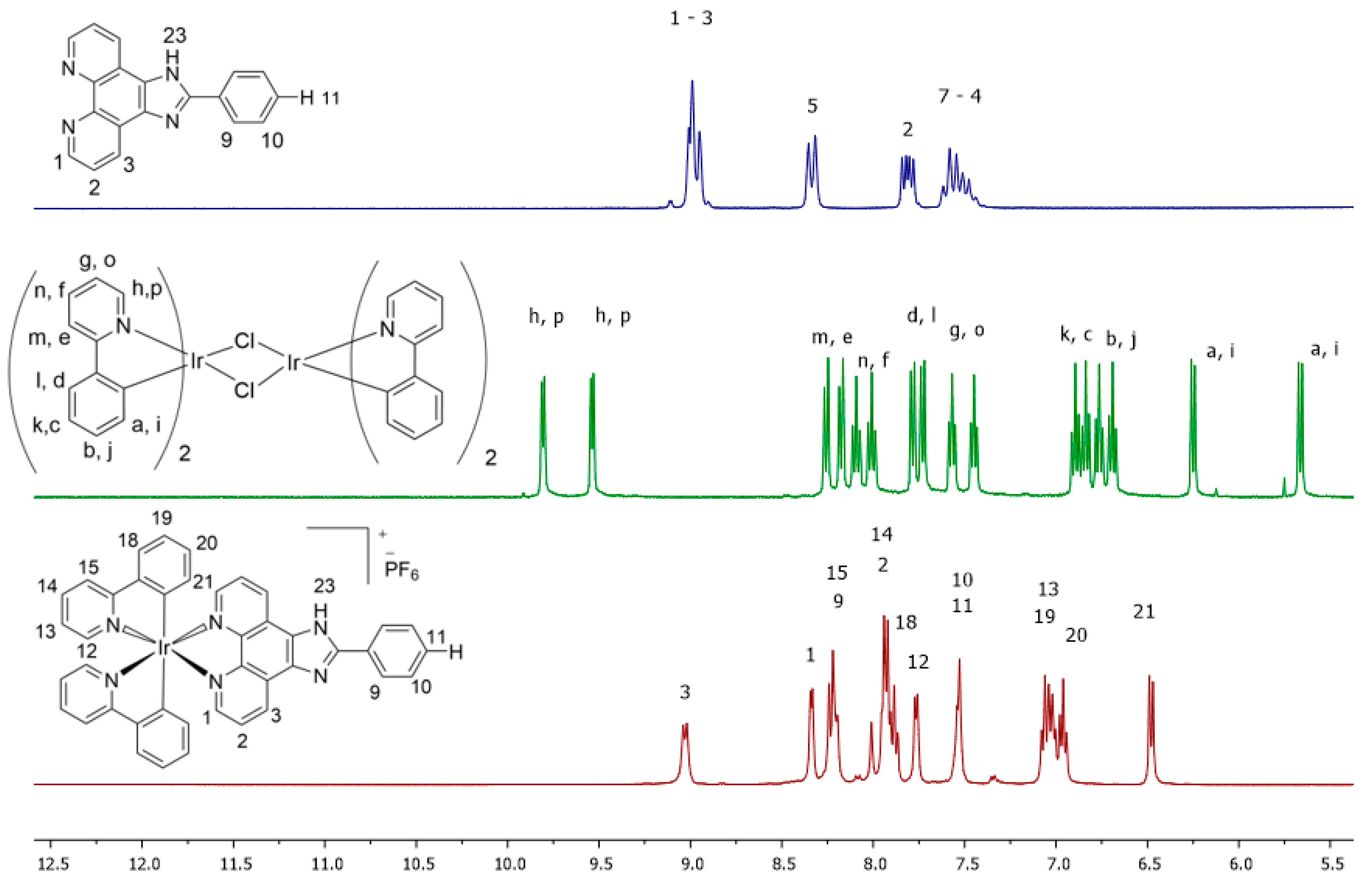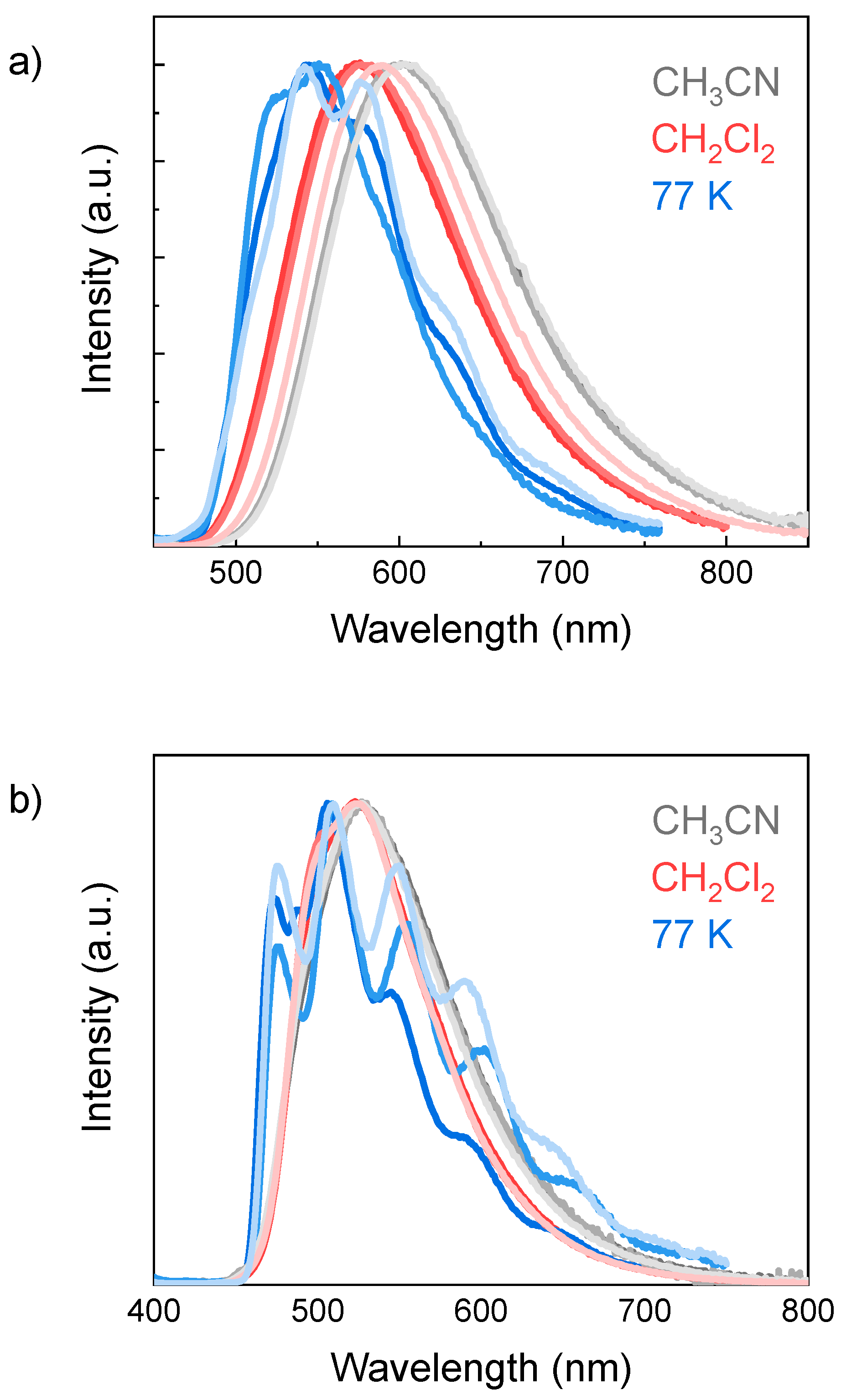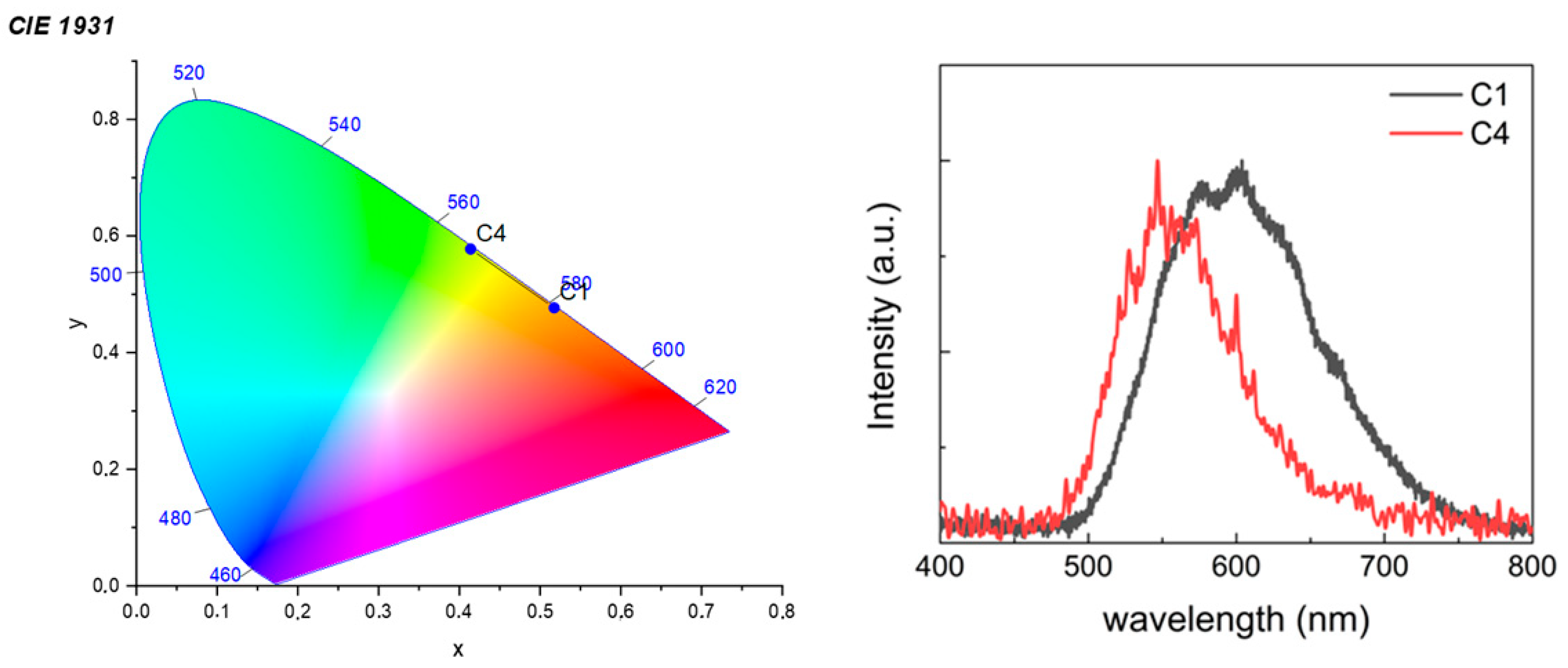Synthesis and Characterization of Iridium(III) Complexes with Substituted Phenylimidazo(4,5-f)1,10-phenanthroline Ancillary Ligands and Their Application in LEC Devices
Abstract
:1. Introduction
2. Results and Discussion
2.1. Synthesis and Characterization of Compounds
2.2. Electrochemical Behavior
2.3. Photophysical Properties
2.4. Electroluminescent Properties (EL)
3. Experimental Section
3.1. General Information and Materials
3.2. Device Preparation and Measurement
4. Conclusions
Supplementary Materials
Author Contributions
Funding
Institutional Review Board Statement
Informed Consent Statement
Data Availability Statement
Conflicts of Interest
References
- Bizzarri, C.; Spuling, E.; Knoll, D.M.; Volz, D.; Bräse, S. Sustainable Metal Complexes for Organic Light-Emitting Diodes (OLEDs). Coord. Chem. Rev. 2018, 373, 49–82. [Google Scholar] [CrossRef]
- Yersin, H.; Rausch, A.F.; Czerwieniec, R.; Hofbeck, T.; Fischer, T. The Triplet State of Organo-Transition Metal Compounds. Triplet Harvesting and Singlet Harvesting for Efficient OLEDs. Coord. Chem. Rev. 2011, 255, 2622–2652. [Google Scholar] [CrossRef]
- Costa, R.D.; Ortí, E.; Bolink, H.J.; Monti, F.; Accorsi, G.; Armaroli, N. Luminescent Ionic Transition-Metal Complexes for Light-Emitting Electrochemical Cells. Angew. Chem. Int. Ed. 2012, 51, 8178–8211. [Google Scholar] [CrossRef] [PubMed]
- Tang, S.; Edman, L. Light-Emitting Electrochemical Cells: A Review on Recent Progress. Top. Curr. Chem. 2016, 374, 40. [Google Scholar] [CrossRef]
- Negi, S.; Mittal, P.; Kumar, B. Impact of Different Layers on Performance of OLED. Microsyst. Technol. 2018, 24, 4981–4989. [Google Scholar] [CrossRef]
- Slinker, J.D.; DeFranco, J.A.; Jaquith, M.J.; Silveira, W.R.; Zhong, Y.-W.; Moran-Mirabal, J.M.; Craighead, H.G.; Abruña, H.D.; Marohn, J.A.; Malliaras, G.G. Direct Measurement of the Electric-Field Distribution in a Light-Emitting Electrochemical Cell. Nat. Mater. 2007, 6, 894–899. [Google Scholar] [CrossRef]
- Chen, B.; Li, Y.; Yang, W.; Luo, W.; Wu, H. Efficient Sky-Blue and Blue-Green Light-Emitting Electrochemical Cells Based on Cationic Iridium Complexes Using 1,2,4-Triazole-Pyridine as the Ancillary Ligand with Cyanogen Group in Alkyl Chain. Org. Electron. 2011, 12, 766–773. [Google Scholar] [CrossRef]
- Schneider, G.E.; Pertegás, A.; Constable, E.C.; Housecroft, C.E.; Hostettler, N.; Morris, C.D.; Zampese, J.A.; Bolink, H.J.; Junquera-Hernández, J.M.; Ortí, E.; et al. Bright and Stable Light-Emitting Electrochemical Cells Based on an Intramolecularly π-Stacked, 2-Naphthyl-Substituted Iridium Complex. J. Mater. Chem. C 2014, 2, 7047–7055. [Google Scholar] [CrossRef]
- Jespersen, D.; Keen, B.; Day, J.I.; Singh, A.; Briles, J.; Mullins, D.; Weaver, J.D. Solubility of Iridium and Ruthenium Organometallic Photoredox Catalysts. Org. Process Res. Dev. 2019, 23, 1087–1095. [Google Scholar] [CrossRef]
- Bowler, M.H.; Mishra, A.; Adams, A.C.; Blangy, C.L.-D.; Slinker, J.D. Circumventing Dedicated Electrolytes in Light-Emitting Electrochemical Cells. Adv. Funct. Mater. 2020, 30, 1906715. [Google Scholar] [CrossRef]
- Shao, Y.; Bazan, G.C.; Heeger, A.J. Long-Lifetime Polymer Light-Emitting Electrochemical Cells. Adv. Mater. 2007, 19, 365–370. [Google Scholar] [CrossRef]
- Pashaei, B.; Karimi, S.; Shahroosvand, H.; Abbasi, P.; Pilkington, M.; Bartolotta, A.; Fresta, E.; Fernandez-Cestau, J.; Costa, R.D.; Bonaccorso, F. Polypyridyl Ligands as a Versatile Platform for Solid-State Light-Emitting Devices. Chem. Soc. Rev. 2019, 48, 5033–5139. [Google Scholar] [CrossRef] [PubMed]
- Arias, M.; Concepción, J.; Crivelli, I.; Delgadillo, A.; Díaz, R.; Francois, A.; Gajardo, F.; López, R.; Leiva, A.M.; Loeb, B. Influence of Ligand Structure and Molecular Geometry on the Properties of D6 Polypyridinic Transition Metal Complexes. Chem. Phys. 2006, 326, 54–70. [Google Scholar] [CrossRef]
- Strouse, G.F.; Schoonover, J.R.; Duesing, R.; Boyde, S.; Jones, W.E., Jr.; Meyer, T.J. Influence of Electronic Delocalization In Metal-to-Ligand Charge Transfer Excited States. Inorg. Chem. 1995, 34, 473–487. [Google Scholar] [CrossRef]
- González, I.; Cortés-Arriagada, D.; Dreyse, P.; Sanhueza-Vega, L.; Ledoux-Rak, I.; Andrade, D.; Brito, I.; Toro-Labbé, A.; Soto-Arriaza, M.; Caramori, S.; et al. A Family of Ir III Complexes with High Nonlinear Optical Response and Their Potential Use in Light-Emitting Devices. Eur. J. Inorg. Chem. 2015, 2015, 4946–4955. [Google Scholar] [CrossRef]
- Dilworth, J.R. Rhenium Chemistry—Then and Now. Coord. Chem. Rev. 2021, 436, 213822. [Google Scholar] [CrossRef]
- Zhao, G.-W.; Zhao, J.-H.; Hu, Y.-X.; Zhang, D.-Y.; Li, X. Recent Advances of Neutral Rhenium(I) Tricarbonyl Complexes for Application in Organic Light-Emitting Diodes. Synth. Met. 2016, 212, 131–141. [Google Scholar] [CrossRef]
- Walters, K.A.; Kim, Y.-J.; Hupp, J.T. Experimental Studies of Light-Induced Charge Transfer and Charge Redistribution in (X2-Bipyridine)ReI(CO)3Cl Complexes. Inorg. Chem. 2002, 41, 2909–2919. [Google Scholar] [CrossRef]
- Szłapa-Kula, A.; Palion-Gazda, J.; Ledwon, P.; Erfurt, K.; Machura, B. A Fundamental Role of the Solvent Polarity and Remote Substitution of the 2-(4-R-Phenyl)-1 H-Imidazo[4,5-f][1,10]Phenanthroline Framework in Controlling the Ground- and Excited-State Properties of Re(i) Chromophores [ReCl(CO)3(R-C6H4 -Imphen)]. Dalton Trans. 2022, 51, 14466–14481. [Google Scholar] [CrossRef]
- Xu, S.-X.; Wang, J.-L.; Zhao, F.; Xia, H.-Y.; Wang, Y. Copper(I) Complexes of Phenanthrolineimidazole Ligands: Structures, Photophysical Properties, and Quantum Chemical Studies. Transit. Met. Chem. 2015, 40, 723–732. [Google Scholar] [CrossRef]
- Brunner, F.; Babaei, A.; Pertegás, A.; Junquera-Hernández, J.M.; Prescimone, A.; Constable, E.C.; Bolink, H.J.; Sessolo, M.; Ortí, E.; Housecroft, C.E. Phosphane Tuning in Heteroleptic [Cu(N^N)(P^P)] + Complexes for Light-Emitting Electrochemical Cells. Dalton Trans. 2019, 48, 446–460. [Google Scholar] [CrossRef]
- Fresta, E.; Mahoro, G.U.; Cavinato, L.M.; Lohier, J.; Renaud, J.; Gaillard, S.; Costa, R.D. Novel Red-Emitting Copper(I) Complexes with Pyrazine and Pyrimidinyl Ancillary Ligands for White Light-Emitting Electrochemical Cells. Adv. Opt. Mater. 2022, 10, 2101999. [Google Scholar] [CrossRef]
- Paw, W.; Eisenberg, R. Synthesis, Characterization, and Spectroscopy of Dipyridocatecholate Complexes of Platinum. Inorg. Chem. 1997, 36, 2287–2293. [Google Scholar] [CrossRef] [PubMed]
- Nonoyama, M. Benzo[ h ]Quinolin-10-Yl- N Iridium(III) Complexes. Bull. Chem. Soc. Jpn. 1974, 47, 767–768. [Google Scholar] [CrossRef]
- Costa, R.D.; Ortí, E.; Bolink, H.J. Recent Advances in Light-Emitting Electrochemical Cells. Pure Appl. Chem. 2011, 83, 2115–2128. [Google Scholar] [CrossRef]
- Zhao, Q.; Liu, S.; Shi, M.; Li, F.; Jing, H.; Yi, T.; Huang, C. Tuning Photophysical and Electrochemical Properties of Cationic Iridium(III) Complex Salts with Imidazolyl Substituents by Proton and Anions. Organometallics 2007, 26, 5922–5930. [Google Scholar] [CrossRef]
- Castor, K.J.; Metera, K.L.; Tefashe, U.M.; Serpell, C.J.; Mauzeroll, J.; Sleiman, H.F. Cyclometalated Iridium(III) Imidazole Phenanthroline Complexes as Luminescent and Electrochemiluminescent G-Quadruplex DNA Binders. Inorg. Chem. 2015, 54, 6958–6967. [Google Scholar] [CrossRef]
- Ma, X.; Tian, H. Photochemistry and Photophysics. Concepts, Research, Applications. By Vincenzo Balzani, Paola Ceroni and Alberto Juris. Angew. Chem. Int. Ed. 2014, 53, 8817. [Google Scholar] [CrossRef]
- Bolink, H.J.; Coronado, E.; Costa, R.D.; Ortí, E.; Sessolo, M.; Graber, S.; Doyle, K.; Neuburger, M.; Housecroft, C.E.; Constable, E.C. Inside Front Cover: Long-Living Light-Emitting Electrochemical Cells—Control through Supramolecular Interactions. Adv. Mater. 2008, 20, 3910–3913. [Google Scholar] [CrossRef]
- Tang, H.; Li, Y.; Chen, Q.; Chen, B.; Qiao, Q.; Yang, W.; Wu, H.; Cao, Y. Efficient Yellow–Green Light-Emitting Cationic Iridium Complexes Based on 1,10-Phenanthroline Derivatives Containing Oxadiazole-Triphenylamine Unit. Dye. Pigment. 2014, 100, 79–86. [Google Scholar] [CrossRef]
- Sajoto, T.; Djurovich, P.I.; Tamayo, A.B.; Oxgaard, J.; Goddard, W.A.; Thompson, M.E. Temperature Dependence of Blue Phosphorescent Cyclometalated Ir(III) Complexes. J. Am. Chem. Soc. 2009, 131, 9813–9822. [Google Scholar] [CrossRef] [PubMed]
- Dreyse, P.; González, I.; Cortés-Arriagada, D.; Ramírez, O.; Salas, I.; González, A.; Toro-Labbe, A.; Loeb, B. New Cyclometalated Ir(iii) Complexes with Bulky Ligands with Potential Applications in LEC Devices: Experimental and Theoretical Studies of Their Photophysical Properties. New J. Chem. 2016, 40, 6253–6263. [Google Scholar] [CrossRef]
- González, I.; Natali, M.; Cabrera, A.R.; Loeb, B.; Maze, J.; Dreyse, P. Substituent Influence in Phenanthroline-Derived Ancillary Ligands on the Excited State Nature of Novel Cationic Ir(iii) Complexes. New J. Chem. 2018, 42, 6644–6654. [Google Scholar] [CrossRef]
- Schmid, M.-A.; Rentschler, M.; Frey, W.; Tschierlei, S.; Karnahl, M. Imidazo-Phenanthroline Ligands as a Convenient Modular Platform for the Preparation of Heteroleptic Cu(I) Photosensitizers. Inorganics (Basel) 2018, 6, 134. [Google Scholar] [CrossRef]
- Cortés-Arriagada, D.; Sanhueza, L.; González, I.; Dreyse, P.; Toro-Labbé, A. About the Electronic and Photophysical Properties of Iridium(iii)-Pyrazino[2,3-f][1,10]-Phenanthroline Based Complexes for Use in Electroluminescent Devices. Phys. Chem. Chem. Phys. 2016, 18, 726–734. [Google Scholar] [CrossRef]
- Liu, C.; Rao, X.; Lv, X.; Qiu, J.; Jin, Z. Substituent Effects on the Photophysical and Electrochemical Properties of Iridium(III) Complexes Containing an Arylcarbazolyl Moiety. Dye. Pigment. 2014, 109, 13–20. [Google Scholar] [CrossRef]
- Montalti, M.; Credi, A.; Prodi, L.; Gandolfi, M.T. Handbook of Photochemistry; CRC Press: Boca Ratón, FL, USA, 2006; ISBN 9780429115387. [Google Scholar]
- You, Y.; Park, S.Y. Inter-Ligand Energy Transfer and Related Emission Change in the Cyclometalated Heteroleptic Iridium Complex: Facile and Efficient Color Tuning over the Whole Visible Range by the Ancillary Ligand Structure. J. Am. Chem. Soc. 2005, 127, 12438–12439. [Google Scholar] [CrossRef]
- Beeby, A.; Bettington, S.; Samuel, I.D.W.; Wang, Z. Tuning the Emission of Cyclometalated Iridium Complexes by Simple Ligand Modification. J. Mater. Chem. 2003, 13, 80–83. [Google Scholar] [CrossRef]
- Ravotto, L.; Ceroni, P. Aggregation Induced Phosphorescence of Metal Complexes: From Principles to Applications. Coord. Chem. Rev. 2017, 346, 62–76. [Google Scholar] [CrossRef]
- Alsaeedi, M.S. Insight into Luminescent Iridium Complexes: Their Potential in Light-Emitting Electrochemical Cells. J. Saudi. Chem. Soc. 2022, 26, 101442. [Google Scholar] [CrossRef]
- Lo, K.K.; Chung, C.; Zhu, N. Nucleic Acid Intercalators and Avidin Probes Derived from Luminescent Cyclometalated Iridium(III)–Dipyridoquinoxaline and –Dipyridophenazine Complexes. Chem. Eur. J. 2006, 12, 1500–1512. [Google Scholar] [CrossRef]
- Troian-Gautier, L.; Moucheron, C. Ruthenium II Complexes Bearing Fused Polycyclic Ligands: From Fundamental Aspects to Potential Applications. Molecules 2014, 19, 5028–5087. [Google Scholar] [CrossRef] [PubMed]
- González, I.; Dreyse, P.; Cortés-Arriagada, D.; Sundararajan, M.; Morgado, C.; Brito, I.; Roldán-Carmona, C.; Bolink, H.J.; Loeb, B. A Comparative Study of Ir(iii) Complexes with Pyrazino[2,3-f][1,10]Phenanthroline and Pyrazino[2,3-f][4,7]Phenanthroline Ligands in Light-Emitting Electrochemical Cells (LECs). Dalton Trans. 2015, 44, 14771–14781. [Google Scholar] [CrossRef] [PubMed]
- Cao, H.-T.; Ding, L.; Yu, J.; Shan, G.-G.; Wang, T.; Sun, H.-Z.; Gao, Y.; Xie, W.-F.; Su, Z.-M. Manipulating Phosphorescence Efficiencies of Orange Iridium(III) Complexes through Ancillary Ligand Control. Dye. Pigment. 2019, 160, 119–127. [Google Scholar] [CrossRef]
- Zhang, J.; Yu, Q.; Li, Q.; Yang, L.; Chen, L.; Zhou, Y.; Liu, J. A Ruthenium(II) Complex Capable of Inducing and Stabilizing Bcl-2 G-Quadruplex Formation as a Potential Cancer Inhibitor. J. Inorg. Biochem. 2014, 134, 1–11. [Google Scholar] [CrossRef] [PubMed]
- Lowry, M.S.; Goldsmith, J.I.; Slinker, J.D.; Pascal, R.A.; Malliaras, G.G.; Bernhard, S. Correction to Single-Layer Electroluminescent Devices and Photoinduced Hydrogen Production from an Ionic Iridium(III) Complex. Chem. Mater. 2023, 35, 1466. [Google Scholar] [CrossRef]
- Hendi, Z.; Kozina, D.O.; Porsev, V.V.; Kisel, K.S.; Shakirova, J.R.; Tunik, S.P. Investigation of the N^C Ligand Effects on Emission Characteristics in a Series of Bis-Metalated [Ir(N^C)2(N^N)]+ Complexes. Molecules 2023, 28, 2740. [Google Scholar] [CrossRef]
- Xu, H.; Zheng, K.-C.; Deng, H.; Lin, L.-J.; Zhang, Q.-L.; Ji, L.-N. Effects of the Ancillary Ligands of Polypyridyl Ruthenium(Ii) Complexes on the DNA-Binding Behaviors. New J. Chem. 2003, 27, 1255. [Google Scholar] [CrossRef]
- Henwood, A.F.; Zysman-Colman, E. Luminescent Iridium Complexes Used in Light-Emitting Electrochemical Cells (LEECs). Top. Curr. Chem. 2016, 374, 36. [Google Scholar] [CrossRef]
- Bolink, H.J.; Cappelli, L.; Cheylan, S.; Coronado, E.; Costa, R.D.; Lardiés, N.; Nazeeruddin, M.K.; Ortí, E. Origin of the large spectral shift in electroluminescence in a blue light emitting cationic iridium (III) complex. J. Mater. Chem. 2007, 17, 5032–5041. [Google Scholar] [CrossRef]
- Zhao, Q.; Cao, T.; Li, F.; Li, X.; Jing, H.; Yi, T.; Huang, C. A highly selective and multisignaling optical− electrochemical sensor for Hg2+ based on a phosphorescent iridium (III) complex. Organometallics 2007, 26, 2077–2081. [Google Scholar] [CrossRef]
- Xu, H.; Liang, Y.; Zhang, P.; Du, F.; Zhou, B.-R.; Wu, J.; Liu, J.-H.; Liu, Z.-G.; Ji, L.-N. Biophysical studies of a ruthenium (II) polypyridyl complex binding to DNA and RNA prove that nucleic acid structure has significant effects on binding behaviors. J. Biol. Inorg. Chem. 2005, 10, 529–538. [Google Scholar] [CrossRef] [PubMed]
- De, S.; Kumar, R.S.; Gauthaman, A.; Kumar, S.K.A.; Paira, P.; Moorthy, A.; Banerjee, S. Luminescent ruthenium (II)-para-cymene complexes of aryl substituted imidazo-1, 10-phenanthroline as anticancer agents and the effect of remote substituents on cytotoxic activities. Inorg. Chim. Acta 2021, 515, 120066. [Google Scholar] [CrossRef]





| Complex | Eox (V) | Ered,1 (V) | Ered,2 (V) | ∆E (V) |
|---|---|---|---|---|
| C1 | 0.88 | −1.81 | −2.04 | 2.69 |
| C2 | 0.89 | −1.81 | −2.06 | 2.70 |
| C3 | 0.88 | −1.80 | −2.06 | 2.68 |
| C4 | 1.10 | −1.74 | −1.98 | 2.84 |
| C5 | 1.11 | −1.75 | −1.98 | 2.86 |
| C6 | 1.12 | −1.74 | −1.98 | 2.86 |
| λabs/nm | ||
|---|---|---|
| Complex | CH3CN | CH2Cl2 |
| C1 | 276, 297, 345, 384, 403 | 278, 298, 346 (sh), 388, 412 |
| C2 | 279, 294 (sh), 381, 403 | 280, 299 (sh), 389, 414 |
| C3 | 274, 295, 341 (sh), 381, 406 | 276, 296, 345 (sh), 387, 412 |
| C4 | 277, 300, 347, 378 | 278, 303 (sh), 352, 387 |
| C5 | 279, 301, 349, 384 | 281, 304 (sh), 358, 390 |
| C6 | 277, 301 (sh), 346, 379 | 278, 303 (sh), 355, 390 |
| λmax (nm) | Φ b | τ/μs c | ||||||
|---|---|---|---|---|---|---|---|---|
| Complex | CH3CN | CH2Cl2 | 77 K a | CH3CN | CH2Cl2 | CH3CN | CH2Cl2 | 77 K a |
| C1 | 602 | 574 | 577,540 | 0.18 | 0.35 | 0.63 | 0.89 | 4.47 |
| C2 | 600 | 576 | 550,524 | 0.16 | 0.36 | 0.58 | 0.96 | 5.48 |
| C3 | 603 | 588 | 577,540 | 0.18 | 0.31 | 0.53 | 0.77 | 4.70 |
| C4 | 528 | 522 | 544,507,473 | 0.39 | 0.60 | 4.66 | 3.95 | 7.5; 37.9 |
| C5 | 528 | 525 | 553,509,474 | 0.27 | 0.61 | 5.67 | 5.02 | 13.6; 62.4 |
| C6 | 527 | 523 | 549,508,475 | 0.35 | 0.63 | 4.99 | 4.57 | 12.5; 57.1 |
| iTMC | λEL | Vturn.on (V) a | Lmax (Lx) b | Vmax (V) |
|---|---|---|---|---|
| C1 | 596 | 3.5 | 15.5 | 15 |
| C2 | 587 | 2.9 | 21.7 | 14.7 |
| C3 | 579 | 3.9 | 16.1 | 14 |
| C4 | 527 | 4.4 | 3.5 | 8 |
| C5 | 523 | 3 | 4.4 | 8.3 |
| C6 | 528 | 3.5 | 4.1 | 7.9 |
Disclaimer/Publisher’s Note: The statements, opinions and data contained in all publications are solely those of the individual author(s) and contributor(s) and not of MDPI and/or the editor(s). MDPI and/or the editor(s) disclaim responsibility for any injury to people or property resulting from any ideas, methods, instructions or products referred to in the content. |
© 2023 by the authors. Licensee MDPI, Basel, Switzerland. This article is an open access article distributed under the terms and conditions of the Creative Commons Attribution (CC BY) license (https://creativecommons.org/licenses/by/4.0/).
Share and Cite
Vásquez, B.; Bayas, M.; Dreyse, P.; Palma, J.L.; Cabrera, A.R.; Rossin, E.; Natali, M.; Saldias, C.; González-Pavez, I. Synthesis and Characterization of Iridium(III) Complexes with Substituted Phenylimidazo(4,5-f)1,10-phenanthroline Ancillary Ligands and Their Application in LEC Devices. Molecules 2024, 29, 53. https://doi.org/10.3390/molecules29010053
Vásquez B, Bayas M, Dreyse P, Palma JL, Cabrera AR, Rossin E, Natali M, Saldias C, González-Pavez I. Synthesis and Characterization of Iridium(III) Complexes with Substituted Phenylimidazo(4,5-f)1,10-phenanthroline Ancillary Ligands and Their Application in LEC Devices. Molecules. 2024; 29(1):53. https://doi.org/10.3390/molecules29010053
Chicago/Turabian StyleVásquez, Bárbara, Max Bayas, Paulina Dreyse, Juan Luis Palma, Alan R. Cabrera, Elena Rossin, Mirco Natali, Cesar Saldias, and Iván González-Pavez. 2024. "Synthesis and Characterization of Iridium(III) Complexes with Substituted Phenylimidazo(4,5-f)1,10-phenanthroline Ancillary Ligands and Their Application in LEC Devices" Molecules 29, no. 1: 53. https://doi.org/10.3390/molecules29010053
APA StyleVásquez, B., Bayas, M., Dreyse, P., Palma, J. L., Cabrera, A. R., Rossin, E., Natali, M., Saldias, C., & González-Pavez, I. (2024). Synthesis and Characterization of Iridium(III) Complexes with Substituted Phenylimidazo(4,5-f)1,10-phenanthroline Ancillary Ligands and Their Application in LEC Devices. Molecules, 29(1), 53. https://doi.org/10.3390/molecules29010053







